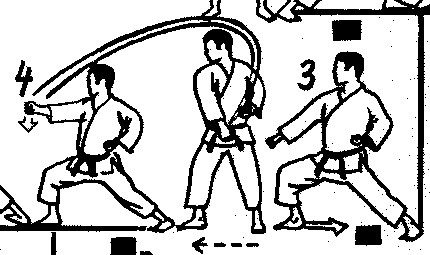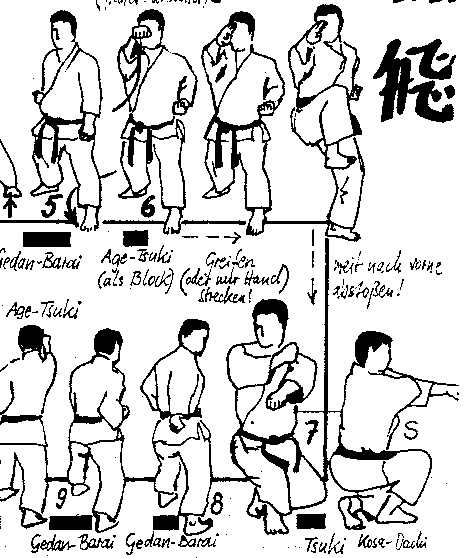Der Weg von der Ausholbewegung zum Vorblock bzw. Konter und vom Block zum Angriff
Im Grundschultraining der Anfänger wird viel Wert auf eine korrekte Ausholbewegung bei Blöcken gelegt. Die Gründe dafür sind vielfältig. Dem Anfänger fällt es schwer, beide Arme in unterschiedlichen, aber gleichzeitigen Bewegungsabläufen zu nutzen. Ein "ungefährliches" Ausholen trainiert dabei diese Fertigkeiten. Weiterhin kann eine Ausholbewegung als Hilfe für den blockenden Arm genutzt werden, um die korrekte Bewegung des Blockes zu erlernen. Ein Beispiel hierfür wäre der Gedan-Barai, bei dem der Ausholarm in der korrekten Position leicht schräg nach unten vorn als "Schiene" des Gedan-Barai-Armes dienen kann oder auch der Soto-Uke, bei dem der Ausholarm als Endpunkt des Soto-Uke dient, um die richtige Endstellung zu finden.Im weiteren Verlauf des Trainings bei etwas fortgeschrittenen Schülern wird die Ausholbewegung als Distanzhelfer erklärt, um den Gegner auf der richtigen Distanz zu halten. Ein Beispiel dafür wäre die Ausholbewegung des Age-Uke. Eine weitere gern genutzte Erklärung auf diesem Trainingslevel ist, die Ausholbewegung als ausgleichende Gegenbewegung des eigentlichen Blockes zu sehen und um ein kraftvolles Hikite zu erzeugen. Als weiterführende Erklärung wäre dann hier noch das Heranziehen des Gegners mittels Hikite-Bewegung genannt.
In einem richtigen Kampf machen die oben genannten Erklärungen jedoch nicht wirklich Sinn, da hier in der Regel keine Zeit zu verschwenden ist. Wiederum gibt es im Karate keine sinnlosen Dinge und so kommt man zwangsläufig dahin zu untersuchen, welcher Sinn wirklich dahinter steckt.
Aus meiner Sicht kann jede Ausholbewegung der Blöcke direkt als Vorblock oder auch direkter Konter angesehen werden: Beispiele zur Umwandlung der Ausholbewegung des nichtblockenden Arms in einen Block oder Konter:
- Gedan-Barai: Ausführung als Gedan-Zuki oder Nagashi-Uke
- Age-Uke: Ausführung als Age-Zuki oder als Uraken
- Uchi-Uke: Ausführung als Nagashi-Uke, als Doppelblock (Übernahme des gegnerischen Arms) oder als Tsuki
- Soto-Uke: Ausführung als Tsuki
- Shuto-Uke: Ausführung als Nukite oder beide Hände als Nagashi-Uke
Auch dafür gibt es eine logische Erklärung. Der ursprüngliche Block wird für einen eventuellen zweiten Gegner oder einem eventuellen zweiten Angriff desselben Gegners verstanden. Weiterhin kann auch jeder Block als Angriff ausgeführt, umgewandelt oder interpretiert werden, so dass der bisherige Block als zweiter Konter (falls die Ausholbewegung schon Konter war) oder direkt als Konter (falls die Ausholbewegung ein Block war) angesehen werden. Damit ist allerdings nicht gemeint, dass der Block "normal" ausgeführt wird, sondern es geht um eine Umwandlung in eine andere Technik. Ich gehe hier mal davon aus, dass es allgemein bekannt ist, dass jeder Block weich, als "mitnehmende Aufnahme", aber auch hart, als "zerstörender Block" ausgeführt werden kann. Beispiele zur Umwandlung eines Blocks in einen Konter oder Angriff
- Gedan-Barai: Ausführung als Uraken, Befreiuung aus Festhalte
- Age-Uke: Ausführung als Uraken, Age-Zuki oder als Hebel
- Uchi-Uke: Ausführung als Hebel, indem der Ausholarm den gegnerischen Arm fixiert
- Soto-Uke: Ausführung als Hebel, in dem der Ausholarm den gegnerischen Arm fixiert, als armbrechende Technik oder Umwandlung in Shuto-Uchi
- Shuto-Uke: Ausführung als Shuto-Uchi oder Uraken
- Ausholbewegung Gedan-Barai: Ausführung als Tsuki nach hinten oder als weiteren Nagashi-Uke
- Ausholbewegung Age-Uke: Ausführung als Ushiro-Empi nach hinten
- Ausholbewegung Uchi-Uke: Ausführung als Kakie-Zuki oder als Wurf
- Ausholbewegung Soto-Uke: Ausführung als Haiwan-Nagashi-Uke wie in Tekki-Shodan
- Ausholbewegung Shuto-Uke: Ausführung als weiteren Nagashi-Uke
 In der Kata wäre das die Bewegung aus dem Gedan-Barai in den Tetsui-Uchi. Die Standarderklärung ist hier das Befreien aus einer Festhalte. Im Bild mittig dargestellt lässt sich allerdings schon ein zusätzlicher Gedan-Uke erkennen. Im weiteren Verlauf, wenn der Arm über den Kopf wandert, kann auch noch ein Age-Uke als blockendes Element eingefügt werden, so dass wir aus zwei (bzw. drei) Techniken in einem erweiterten Partnertraining auf fünf Techniken kommen, ohne hier überhaupt schon einen Konter mitzuzählen.
In der Kata wäre das die Bewegung aus dem Gedan-Barai in den Tetsui-Uchi. Die Standarderklärung ist hier das Befreien aus einer Festhalte. Im Bild mittig dargestellt lässt sich allerdings schon ein zusätzlicher Gedan-Uke erkennen. Im weiteren Verlauf, wenn der Arm über den Kopf wandert, kann auch noch ein Age-Uke als blockendes Element eingefügt werden, so dass wir aus zwei (bzw. drei) Techniken in einem erweiterten Partnertraining auf fünf Techniken kommen, ohne hier überhaupt schon einen Konter mitzuzählen.
Auf diese Weise entwickelt sich im Laufe der Trainingsjahre ein einfacher simpler Block zu einem komplexen Konstrukt aus zwei bis drei Techniken, um notfalls mehrere Angriffe oder Gegner anzunehmen. Der Übergang zwischen Ausholbewegungen, Vorblock, Block und Konter wird so fließend.
Als Übungsbeispiel sei an dieser Stelle einmal die folgende Kombination aus der Kata Empi genannt, welche sich für verschiedene Nutzungsarten unter obiger Betrachtung anbietet:
 Von Position 6 auf 7:
Je nach Angriff und Abstand des Gegners blockt der rechte Arm mit Age-Uke, blockt mit Age-Zuki auf des Gegners Arm oder kontert direkt mit Age-Zuki. Danach greift der rechte Arm entweder den Arm des Gegners mit nachfolgendem Mae-Geri (großer Abstand) oder er greift hinter das Genick mit nachfolgendem Hiza-Geri (geringer Abstand). Beim Reingleiten in den Kosa-Dachi hängt es wieder vom Gegner ab, ob der linke Arm ein Tsuki ist oder nur für den nachfolgenden Gedan-Barai ausholt oder mit Nagashi-Uke blockt. Gleiches gilt für den rechten Arm. Ausholbewegung des Gedan-Barai oder Nagashi-Uke-Jodan.
Von Position 7 auf 8:
Falls der Gegner den linken Arm festhält, erfolgt kein Gedan-Barai gegen einen Mae-Geri von hinten, sondern ein Befreiungsschlag gegen die Festhalte oder ein Gedan-Uraken als Konter.
Von Position 6 auf 7:
Je nach Angriff und Abstand des Gegners blockt der rechte Arm mit Age-Uke, blockt mit Age-Zuki auf des Gegners Arm oder kontert direkt mit Age-Zuki. Danach greift der rechte Arm entweder den Arm des Gegners mit nachfolgendem Mae-Geri (großer Abstand) oder er greift hinter das Genick mit nachfolgendem Hiza-Geri (geringer Abstand). Beim Reingleiten in den Kosa-Dachi hängt es wieder vom Gegner ab, ob der linke Arm ein Tsuki ist oder nur für den nachfolgenden Gedan-Barai ausholt oder mit Nagashi-Uke blockt. Gleiches gilt für den rechten Arm. Ausholbewegung des Gedan-Barai oder Nagashi-Uke-Jodan.
Von Position 7 auf 8:
Falls der Gegner den linken Arm festhält, erfolgt kein Gedan-Barai gegen einen Mae-Geri von hinten, sondern ein Befreiungsschlag gegen die Festhalte oder ein Gedan-Uraken als Konter.
The way from the forward movement to the block or counter and from the block to the attack
In the basic training of the beginners much emphasis is placed on a correct Ausholbewegung with blocks. The reasons for this are diverse. The beginner finds it difficult to use both arms in different, but simultaneous movements. A "safe" Ausholen trains these skills. Furthermore, a return movement can be used as help for the blocking arm to learn the correct movement of the block. An example of this would be the Gedan-Barai, in which the recovery arm in the correct position can serve slightly obliquely downwards as the guideway of the Gedan-Barai arm, or even the Soto-Uke, where the recovery arm is the endpoint of the Soto-Uke arm, serve to find the right end position.In the further course of the training in somewhat advanced students, the recovery movement is declared as a distance assistant to keep the opponent at the correct distance. An example of this would be the recovery movement of the Age-Uke. Another popular explanation at this level of training is to see the return movement as a countermovement of the actual block and to create a powerful hikite. As a further explanation, the pull of the opponent by means of a hikite movement would be mentioned here.
In a real fight, however, the above explanations do not really make sense, as there is usually no time to waste. Again, there are no senseless things in karate, and so one inevitably comes to investigate the meaning behind it.
From my point of view, any return movement of the blocks can be viewed directly as a block or direct counter attack: Examples of converting the Ausholbewegung of the non-blocking arm into a block or counter attack:
- Gedan-Barai: executed as Gedan-Zuki or Gedan-Nagashi-Uke
- Age-Uke: executed as Age-Zuki or as Uraken
- Uchi-Uke: executed as Nagashi-Uke, as a double block (takeover of the opposing arm) or as Tsuki
- Soto-Uke: executed as Tsuki
- Shuto-Uke: executed as Nukite or both hands as Nagashi-Uke
There is also a logical explanation for this. The original block is used to control a possible second opponent or to block a possible second attack of the same opponent. Furthermore, each block can be executed as an attack, so that the previous block is a second counter (if the Ausholbewegung was already a counter attack) or directly was as a counter attack (if the Ausholbewegung was a block). However, this does not mean that the block is executed "normally", but it is about a conversion into another technique. I'm assuming that it's common knowledge that every block can be executed smoothly, as a "take the control of the opponents arm", but also hard, as a "destructive block."
Examples of converting a block into a counter attack
- Gedan-Barai: execute as Uraken or release myself from hold through the opponent
- Age-Uke: execute as Uraken, Age-Zuki or as a lever technique
- Uchi-Uke: execute as a lever technique by the Ausholarm fixes the opposing arm
- Soto-Uke: execute as a lever technique by the Ausholarm fixes the opposing arm, as a technique to broke the arm or transformation into Shuto-Uchi
- Shuto-Uke: execute as Shuto-Uchi or Uraken
- Return movement Gedan-Barai: execute as Jodan-Zuki backwards or as another Nagashi-Uke
- Recurring movement Age-Uke: execute as Ushiro-Empi to the rear
- Uchi-Uke recovery movement: execute as Kakie-Zuki or as a throw
- Soto-Uke kick-out movement: execute as Heiwan-Nagashi-Uke to the side like in Tekki-Shodan
- Pull-out movement Shuto-Uke: execute as another Nagashi-Uke
 In the kata that would be the movement from the Gedan-Barai to the Tetsui-Uchi. The standard explanation here is freeing from a hold tight of the opponent. In the picture shown in the middle, however, can already be seen an additional Gedan-Uke. In the further course, if the arm going over the head, also an Age-Uke can be inserted as a blocking element, so that we come from two (or three) techniques in an extended partner training on five techniques.
In the kata that would be the movement from the Gedan-Barai to the Tetsui-Uchi. The standard explanation here is freeing from a hold tight of the opponent. In the picture shown in the middle, however, can already be seen an additional Gedan-Uke. In the further course, if the arm going over the head, also an Age-Uke can be inserted as a blocking element, so that we come from two (or three) techniques in an extended partner training on five techniques.
In this way, during the course of the training years, a simple block develops into a complex construct of two to three techniques, in order to take on several attacks or opponents, if necessary. The transition between outward movements, blooms, block and counter is flowing.
As an exercise example at this point, the following combination of the Kata Empi is called, which offers itself for different types of usage under the above consideration:
 From position 6 to 7:
Depending on the attack and distance of the opponent blocks the right arm with Age-Uke, counter the right arm direct with Age-Zuki on the opponent's arm or counter directly with Age-Zuki. Then the right arm either takes the arm of the opponent with the following Mae-Geri (long distance) or he takes behind the neck with the following Hiza-Geri (short distance). When sliding into the Kosa-Dachi, it depends again on the opponent whether the left arm is a Tsuki or holt aus only for the subsequent Gedan-Barai or blocks with Nagashi-Uke. The same applies to the right arm. Recreational movement of Gedan-Barai or Nagashi-Uke-Jodan.
From position 7 to 8:
If the opponent holds his left arm, there is no Gedan-Barai against a Mae-Geri from behind, but a liberation strike against the hold or a Gedan-Uraken as a counter.
From position 6 to 7:
Depending on the attack and distance of the opponent blocks the right arm with Age-Uke, counter the right arm direct with Age-Zuki on the opponent's arm or counter directly with Age-Zuki. Then the right arm either takes the arm of the opponent with the following Mae-Geri (long distance) or he takes behind the neck with the following Hiza-Geri (short distance). When sliding into the Kosa-Dachi, it depends again on the opponent whether the left arm is a Tsuki or holt aus only for the subsequent Gedan-Barai or blocks with Nagashi-Uke. The same applies to the right arm. Recreational movement of Gedan-Barai or Nagashi-Uke-Jodan.
From position 7 to 8:
If the opponent holds his left arm, there is no Gedan-Barai against a Mae-Geri from behind, but a liberation strike against the hold or a Gedan-Uraken as a counter.

